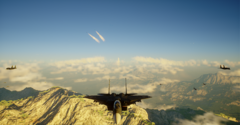Khan of Ulaanbaatar
This article's name is a callsign, a codename, an occupation, or a nickname. There is no known real name for the subject.
- "[chuckles] The Cascadians don't know what it means to fight a war, after this, they will. K-9, we're needed elsewhere until the rest of the Federation Military can arrive in-region, impress me, Magadan needs new Peacekeepers."
- ― The Khan in the aftermath of Mission ASKAR-59[2]
The Khan of Ulaanbaatar is a state representative of the Kingdom of Ulaanbaatar, a Federation Core State. Addressed by royal honorifics (eg. "Your Highness"), he is also a servicemember of the Federation Peacekeepers, leading Peacekeeping Squadron Steel, assigned to his nation.
Biography
The Khan, along with his entire squadron, arrived late to the D-day landing of the Cascadian Conflict's Magadan Invasion due to contending with Federation High Command disorganization, which had lasted for a month.[3] Having heard of Air Reserve Division K-9's ability through fellow Peacekeeper Crimson Team (which K-9 saved)'s testimony, he ordered his unit to work with the reservists to sink the Cascadian Independence Force picket fleet sent ahead of the main force.
He and Bookie of K-9 questioned the rebels' willingness to commit so much to a small stretch of the Federation Core, especially as the bulk of Federation might was either in the Periphery[4] or in Asia.[5] He recognized that their successes can mostly be attributed to Monarch the "Crown," as the dwindling fleet's radio chatter cried. Once the fleet was sunk, he stated the rebels were in for a reckoning and told K-9 to make the most of their service, grooming them for Magadane Peacekeeper membership before announcing departure back to base; until Federation Military Forces could reinforce the country, they were ordered in other locations.[2]
Over half a month later, K-9 pulled enough weight that the rebels were pushed back to where the invasion began. The Khan was ordered with his squadron to hold his position during Mission Kaibir-59, the last battle of the invasion, and later informed AWACS Vita that he and PK Tanager (and elsewhere Crimson Team) were going to repel the invasion fleet, forcing their evacuation efforts to cease and giving K-9 and the others room to cleanse the box they created. Around that time, he also told Captain Flowers they - especially the Peacekeepers - needed to head for Cascadia to steamroll the CIF.
The Khan and his fellow aces severely damaged the CIFS Eminent Domain, the flagship battleship of the CIF, pursuing it even after the onshore invaders' complete annihilation.[4]
Personality and traits
The Khan appears to have much trust in Division K-9's abilities despite their rudimentary standing as reservist pilots, standing in contrast to Crimson 1's initial arrogant dismissal[3] starkly as far as considering them for Peacekeeper application. He holds his branch in high regard when it comes to combat and understands some level of air-to-ground strike mission tactics.
Considering his boast against the Cascadian rebels and reference to Monarch as a Signature - the term for premier ace pilot servants of the Mercenary Cabal Lords - he may have some experience from or knowledge of the Oceanian War, thus potentially saw combat prior to the Cascadian Conflict. He seems to look down on the Cascadian National Guard despite them serving in the aforementioned conflict, perhaps due to their forces' at-large greenhorn nature compared to the minority such as the Black Eagle Division.[2]
References
- ↑ Sector D2 Limited. (2020). Project Wingman [Video game]. Humble Games. Credits (Frontline-59): Voice Actor.
- ↑ 2.0 2.1 2.2 2.3 2.4 Sector D2. (2020). Project Wingman [Video game]. Humble Games. Frontline-59 Mission 02: Home Invasion (Transcript).
- ↑ 3.0 3.1 Sector D2. (2020). Project Wingman [Video game]. Humble Games. Frontline-59 Mission 01: Bottom of the Barrel (Transcript).
- ↑ 4.0 4.1 Sector D2. (2020). Project Wingman [Video game]. Humble Games. Frontline-59 Mission 05: Magadan Front (Transcript).
- ↑ Sector D2. (2020). Project Wingman [Video game]. Humble Games. Frontline-59 Mission 03: Mousetrap (Transcript).
| Federation Military Forces | |||||||||||||||||||||||||||
|---|---|---|---|---|---|---|---|---|---|---|---|---|---|---|---|---|---|---|---|---|---|---|---|---|---|---|---|
| Command Staff | |||||||||||||||||||||||||||
| |||||||||||||||||||||||||||
| Ground Forces (FG) |
| ||||||||||||||||||||||||||
| Ground Navy (GN) |
| ||||||||||||||||||||||||||
| Navy (FN) |
| ||||||||||||||||||||||||||
| Special Forces (SOF) |
| ||||||||||||||||||||||||||
| |||||||||||||||||||||||||||
| Cross-branch |
| ||||||||||||||||||||||||||
| Other | |||||||||||||||||||||||||||
† indicates shootdown/dissolution KIA means "killed in action;" confirmed death POW means "prisoner of war" (RE) indicates part of Reserves | |||||||||||||||||||||||||||

